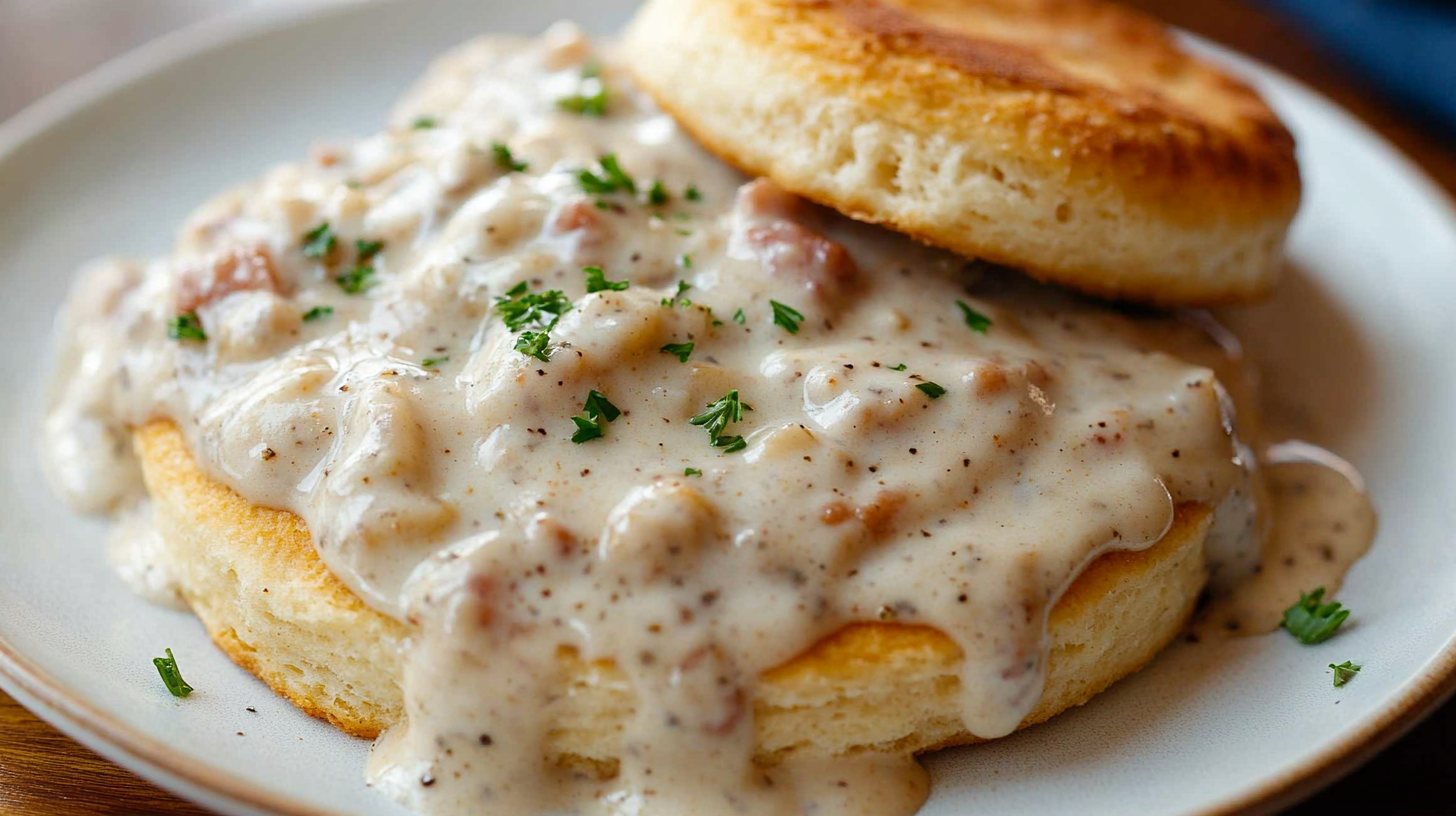Biscuits and gravy is a Southern classic that’s beloved for its rich flavors and comforting texture. This simple dish combines tender, flaky biscuits with a creamy, peppery sausage gravy, creating a breakfast or brunch that’s both filling and satisfying. In this guide, we’ll explore the origins of biscuits and gravy, dive into tips for creating the perfect version from scratch, and look at delicious variations that add a unique twist to this beloved dish. So grab your skillet, preheat your oven, and let’s get started with this ultimate guide to biscuits and gravy!
What Are Biscuits and Gravy?
A Southern Comfort Food Classic
Biscuits and gravy is a popular breakfast dish in the Southern United States, known for its hearty, comforting flavors. At its core, the dish features two essential components: soft, flaky biscuits and a creamy, flavorful gravy, typically made with ground sausage and black pepper. The gravy is poured generously over the biscuits, creating a meal that’s both indulgent and satisfying.
Why Biscuits and Gravy Is So Popular
This classic Southern dish has earned its place on breakfast tables across the U.S. for a few reasons. Not only is it delicious, but it’s also incredibly versatile. You can make the biscuits from scratch or use store-bought versions, and the gravy can be adapted to suit different tastes. Plus, biscuits and gravy are affordable to make, making them accessible for families looking to serve up a hearty meal without breaking the bank.
The History of Biscuits and Gravy
Origins in the American South
Biscuits and gravy trace their roots back to the Southern United States, where the dish first gained popularity in the late 18th century. In colonial times, Southern cooks often had to work with limited ingredients, making simple dishes like biscuits and gravy an ideal option. The dish was filling, inexpensive, and easy to prepare, which made it a staple for working-class families, particularly those involved in farming and other labor-intensive work.
Evolution Over Time
As time passed, biscuits and gravy evolved to include various styles and ingredients. The traditional sausage gravy—made from pan drippings, flour, and milk—became a standard. However, regional variations have added unique twists, like tomato gravy, red-eye gravy, or even vegetarian adaptations that cater to different dietary needs. Today, biscuits and gravy are enjoyed across the U.S. in diners, restaurants, and homes, cherished as both a comfort food and a taste of Southern heritage.
Understanding the Components
Biscuits
The first essential component of biscuits and gravy is, of course, the biscuits. Southern-style biscuits are known for being flaky, buttery, and incredibly soft, with layers that pull apart easily. Traditional Southern biscuits rely on a few key ingredients—all-purpose flour, baking powder, salt, and cold butter—which are combined in a specific way to achieve that light and airy texture.
One of the secrets to creating perfect biscuits is to use cold butter. By cutting the butter into the flour mixture, you create pockets of fat that melt during baking, resulting in a flaky texture. The dough should be handled gently to avoid overworking, which can lead to tough biscuits. Whether you’re making biscuits from scratch or using store-bought options, the quality of the biscuits will set the foundation for your dish.
Gravy
The second essential part of this dish is the gravy, traditionally made from sausage drippings, flour, and milk. This creamy sausage gravy is seasoned with a generous amount of black pepper, giving it a slightly spicy flavor that balances well with the mild, buttery biscuits. In Southern cuisine, the sausage gravy is thick and flavorful, clinging to each bite of biscuit for a rich, comforting experience.
Variations on this classic gravy include tomato gravy, made with tomatoes instead of sausage, and red-eye gravy, which incorporates coffee for a unique flavor profile. Regardless of the type, Southern gravy tends to be thick and creamy, with just the right consistency to smother the biscuits without making them soggy.
How to Make Biscuits and Gravy from Scratch
Ingredients Needed
Making homemade biscuits and gravy from scratch doesn’t require many ingredients, but each one is crucial to achieving the right texture and flavor. Here’s what you’ll need for both the biscuits and the gravy:
Biscuits:
- All-Purpose Flour: The base for the biscuits.
- Baking Powder: Provides the rise, making the biscuits light and fluffy.
- Salt: Enhances flavor.
- Cold Butter: Adds flakiness and richness.
- Milk or Buttermilk: Moistens the dough, creating a soft texture.
Gravy:
- Sausage: Provides flavor and drippings for the gravy.
- All-Purpose Flour: Used to create a roux, which thickens the gravy.
- Milk: The base for the creamy texture.
- Salt and Black Pepper: Essential seasonings for flavor.
Step-by-Step Instructions
- Prepare the Biscuits: In a large mixing bowl, combine the flour, baking powder, and salt. Cut in the cold butter until the mixture resembles coarse crumbs. Gradually add milk or buttermilk, stirring just until the dough comes together. Turn the dough out onto a floured surface, fold it a few times to create layers, and pat it down to about an inch thick. Cut into rounds and place on a baking sheet. Bake at 425°F (220°C) for 12-15 minutes or until golden brown.
- Cook the Sausage: In a large skillet over medium heat, cook the sausage until browned, breaking it up into small crumbles as it cooks. Remove the sausage and set aside, leaving the drippings in the pan.
- Make the Gravy: Add the flour to the sausage drippings, stirring to create a roux. Cook for 1-2 minutes, stirring constantly, to remove the raw flour taste. Gradually whisk in the milk, allowing the gravy to thicken as it simmers. Season with salt and plenty of black pepper. Add the cooked sausage back into the gravy and stir to combine.
- Serve: Split the warm biscuits in half and ladle the sausage gravy generously over them. Serve immediately and enjoy the delicious comfort of homemade biscuits and gravy.
For more detailed instructions, check out Bless This Mess Please’s homemade biscuits and gravy recipe.
Tips for Perfecting Biscuits and Gravy

Achieving Flaky Biscuits
The key to perfect, flaky biscuits is in the preparation. Start with cold butter and handle the dough as little as possible to avoid toughening the texture. Cutting the dough into layers by folding it over itself a few times before baking will also help create those beautiful, fluffy layers.
Creamy Gravy Tips
For a creamy, flavorful gravy, take time with each step. Allow the flour to cook for a minute before adding milk, ensuring the gravy is smooth and free of any raw flour taste. Use whole milk for richness, and season generously with black pepper to add depth. Adjust the gravy’s thickness to your preference by adding more or less milk as needed.
These simple tips can take your biscuits and gravy from good to great, creating a restaurant-quality dish that’s perfect every time.
Variations and Additions
Cheesy Biscuits and Gravy
If you’re a cheese lover, you can take biscuits and gravy to the next level by adding cheese to the mix. Try incorporating shredded cheddar or pepper jack cheese into the biscuit dough for an extra savory flavor. For the gravy, sprinkle cheese on top just before serving, or stir it into the gravy while it’s still hot, allowing it to melt for a creamy, cheesy twist on the classic.
Vegetarian Options
For a vegetarian version of biscuits and gravy, swap out the sausage for flavorful ingredients like sautéed mushrooms, onions, or bell peppers. You can make a rich vegetarian gravy by starting with butter or oil in place of sausage drippings. Add flour to make a roux, then slowly whisk in milk or vegetable broth. Season generously with black pepper and salt, and consider adding herbs like thyme or sage for extra depth.
Spicy Twists
Adding a bit of heat can give biscuits and gravy a lively twist. For a spicy version, use hot sausage or add diced jalapeños to the gravy for a kick. You can also incorporate crushed red pepper flakes or a splash of hot sauce into the gravy while cooking. This version pairs beautifully with a sprinkling of fresh cilantro for garnish, adding both color and flavor.
These variations allow you to adapt the dish to suit different tastes and dietary needs, making it as versatile as it is comforting.
Serving Suggestions
Accompaniments
Biscuits and gravy can be a meal on its own, but pairing it with a few sides makes it even more satisfying. Here are some popular options:
- Scrambled Eggs: The creamy eggs provide a light, fluffy contrast to the rich, hearty gravy.
- Hash Browns or Roasted Potatoes: These crispy sides add texture and make the meal more filling.
- Fresh Fruit: A side of sliced berries, melon, or oranges provides a refreshing balance to the savory flavors.
Toppings and Garnishes
A few simple toppings can enhance both the flavor and presentation of biscuits and gravy:
- Chopped Fresh Herbs: Parsley, chives, or cilantro add color and a hint of freshness.
- Paprika or Smoked Paprika: A light dusting of paprika or smoked paprika on top of the gravy adds visual appeal and a subtle smokiness.
- Hot Sauce or Salsa: A splash of hot sauce or spoonful of salsa can bring extra flavor and a bit of heat.
These additions can elevate your biscuits and gravy, transforming it into a well-rounded breakfast or brunch spread.
Frequently Asked Questions About Biscuits and Gravy
Can I Freeze Biscuits and Gravy?
Yes, both biscuits and gravy can be frozen for future use. To freeze, let the biscuits and gravy cool completely. Wrap the biscuits individually in plastic wrap and place in a freezer-safe bag. For the gravy, store it in an airtight container. When ready to eat, thaw the biscuits and reheat in the oven or microwave. For the gravy, reheat on the stovetop, stirring occasionally, and add a bit of milk if needed to reach the desired consistency.
How Long Does Gravy Last?
Gravy can be stored in the refrigerator for up to 3-4 days in an airtight container. Reheat it gently on the stovetop, stirring occasionally. If it thickens too much, add a splash of milk to thin it back out to your preferred consistency.
Can I Make Biscuits and Gravy Without Sausage?
Certainly! You can make gravy without sausage by using bacon drippings, butter, or oil as the base. Simply follow the same process of creating a roux with flour and adding milk. You can also add seasonings or sautéed mushrooms for flavor and texture.
What Is the Difference Between Sawmill Gravy and Sausage Gravy?
Sawmill gravy and sausage gravy are similar but have subtle differences. Sawmill gravy is made with pan drippings and thickened with flour, sometimes including small amounts of sausage but often made without. Sausage gravy, on the other hand, uses a significant amount of ground sausage as the main ingredient, creating a thicker, meatier gravy.
Why Is My Gravy Too Thick or Too Thin?
If your gravy is too thick, you can thin it out by adding more milk a little at a time until you reach the desired consistency. If it’s too thin, simmer it on low heat, stirring often, until it thickens. Remember that gravy will continue to thicken as it cools, so aim for a slightly thinner consistency if serving immediately.
Conclusion
Biscuits and gravy offer a comforting taste of Southern heritage, with warm, flaky biscuits and creamy sausage gravy that’s rich in flavor. Whether you stick to the traditional recipe or add your own twist with cheese, spice, or vegetarian options, this dish is as versatile as it is satisfying. With these tips, variations, and serving suggestions, you’re all set to create a homemade breakfast that’s sure to please family and friends. So fire up your oven, whip up that gravy, and enjoy this timeless comfort food in all its glory!

